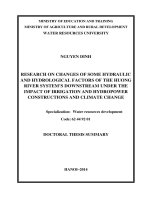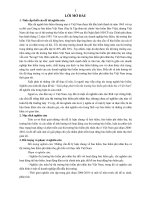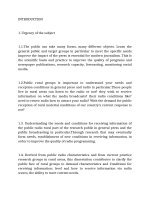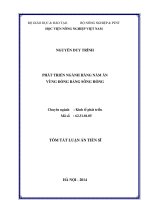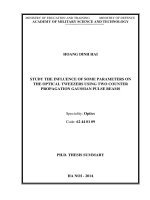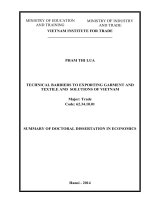tóm tắt luận án tiến sĩ tiếng anh phát triển kỹ năng tự học toán cho sinh viên các trường đại học đào tạo giáo viên tiểu học
Bạn đang xem bản rút gọn của tài liệu. Xem và tải ngay bản đầy đủ của tài liệu tại đây (214.9 KB, 27 trang )
MINISTRY OF EDUCATION AND TRAINING
HANOI NATIONAL UNIVERSITY OF EDUCATION
DO THI PHUONG THAO
DEVELOP MATHS SELF-STUDY SKILLS FOR
PEDAGOGICAL PRIMARY EDUCATION UNIVERSITY
STUDENTS
Speciality: Mathematical theory and teaching methods
Code: 62.14.01.11
SCIENCE EDUCATION PhD THESIS SUMMARY
HÀ NỘI – 2013
1
The Thesis was completed in: Mathematics and informatics
department,
Ha Noi national university of education
Advisors:
1. Junior Prof. Dr. Vũ Quốc Chung
2. Dr. Lê Tuấn Anh
Reviewers 1:
……………………………………………………
……………………………………………………
Reviewers 2:
……………………………………………………
……………………………………………………
Reviewers 3:
……………………………………………………
……………………………………………………
The thesis will be defended at Hanoi national university of
education
Date :
……………………………………………………………….
The thesis is available at:
1. Library of Hanoi national university of education
2. Library of Hai Phong university
2
FOREWORD
1. REASON
Training qualified human resources to meet the increasing demands
of society becomes urgent mission of the Education and Training sector.
Therefore, breakthrough solutions need to be created in teaching methods
by turning the training process into the self-training process. To do so,
trainees should know “what” and “how” to take the initiative to acquire
knowledge. Resolution of the Government on the basic and
comprehensive innovation in universities training in Vietnam (2006 -
2010) clearly stated that universities need to “develop and implement a
roadmap to change annual training into the form of subject complement,
paving the way for students to gain the knowledge". The form of subject
complement will partially turn training process into self-training process
in universities, making students self-studying, active and creative. To
innovate methods of teaching and learning in college and implement the
form training of subject complement, we need to pay special attention to
the strengthening of self-study of students, building active and regular
self-training skills. World Bank calls the twenty-first century as the era of
Skills Based Economy. Universities in developing countries always put
soft skills training priorly. In reality, 85 percentages of successful person
have soft skills. Self study skills play a key role in solf skills. Solf skills
are specially essential with students in Falculty of Elementary Teachers’
Training (ETT), and Maths is very important in ETT program. If students
are aware of the important role of self-study and have measures to train
and develop self-learning skills in maths, the training will gain double
effection. It not only improves training qualification but helps the students
to get skills of self-study and devote their whole lives for work. At the
same time, they are the people whose directly guide and have effect on the
3
formation of soft skills for students at the age of building human
behaviour - elementary students. Education will get higher efficiency if
the training process is turned into self-training process. Although many
students initially had awareness of the meaning of the "self-study" but
have limitation in process due to the lack of a scientific guidance. The
survey results show that "self-study" - forming the active skills to
dominate the knowledge - must be guided by the method of scientific
guidance and real experience.
Starting from the above-mentioned reasons, we have chosen the
title: "Developing maths self-study skills for students in ETT in the
universities".
2. PURPOSES
Give some specific measures to develop maths self-study skills for
students in ETT in the universities, contributing to improvement of the
qualification of teachers in ETT.
3. OBJECTS AND SCOPES
3.1. Objects
Some measures in developing maths self-study skills for students in
ETT in univesities.
3.2. Scopes
Reserch on maths self-learning study skills (mainly base on some
modules: Introduction to statistical theory, Mathsematics 1, Mathsematics
2, Methods of teaching Mathsematics in Primary School) for students in
ETT.
4. HYPOTHESIS
If there are pedagogical methods to develop maths self-study skills
basing on the criteria for evaluating the degree of maths self-study skills,
4
the level of maths self-study skills of students will be enhanced, which
contribute to improve the quality of ETT.
5. TASKS
Systematize and establish the scientific and practical basis for the
development of maths self-study skills of ETT students; survey on the
level and development of maths self-study skills of ETT students in ETT
faculty of some univesities; proposes some specific measures to develop
students' maths self-study skills in ETT faculty; clarify the feasibility and
effectiveness of the subject.
6. METHODS
To complete the research and achieve above purposes, we use the
following main research methods: theory research method; survey –
investigation – synthesis method; experimental pedagogy method.
7. THE CONTRIBUTIONS OF THE THESIS
Contribute to theory of universites’ training measure and practical
basis on necessary to improve maths self-study skills for ETT students.
Elucidate the expression in maths self-study skills of ETT students; the
differences between practical and theoritical in maths self-study and
between maths self-study focused training and non focused training. Build
the criteria for evaluating the level of maths self-study skills of ETT
students. Propose five pedagogical measures to contribute to the
development of maths self-study skills of ETT students.
8. THE PROTECTED POINTS
The guidance and organization for students to self-study, research
and actively gain knowledge are a practical, effective and urgent works.
The guidance and organization for students to self-study, research,
actively gain knowledge and directly join in training progress have not
been paid attention enough neither theory nor practice. The application of
5
the measures to develop maths self-study skills for students will
contribute to the training content and method renewal of ETT students
following the orientation of turning training into self-study training.
9. STRUCTURE OF THE THESIS
Thesia includes: Introduction, Content and Conclusion. The content
of the thesis consists of three chapters: Chapter 1: Theoritical and practical
basis; chapter 2: The measures of development maths self-study skills for
ETT students; chapter 3: Pedagogical practice.
Chapter 1
THEORETICAL AND PRACTICAL BASIS
1.1. Historical overview
1.1.1. The researches in the world
1.1.2. The reseaches in Vietnam
1.1.3. Some conclusions
In general, the above authors have studied the problem in many
ways such as: Self-study is current requirement and necessity for all ages;
dialectical relationship between objective and subjective factors in self-
study progress. . . However, until now, according to the materials that we
accessed, the authors have not mentioned the profound issues such as:
developing specific criteria for self-study skills; practical and theoritical
maths self-study differences; dishtinguishing between promotion and non-
promotion ofmaths self-study skill teaching basis; assessing maths self-
study levels of ETT students; proposing measures to practice self-learning
and self-study of ETT students… Therefore, our research focuses on
objects of students on ETT faculty.
1.2. Scientific basis of self-study
1.2.1. Philosophical basis
1.2.2. Psychological basis
6
1.2.3. Pedagogical basis
1.3. Self-study activities in some active teaching methods
We reseached self-study activities taken place in four teaching
methods towards encouragement learner's activities as below:
1.3.1. Self-study in teaching detecting and solving problems
1.3.2. Self-study in teaching from the point of tectonic theory
1.3.3. Self-study in teaching group activities
1.3.4. Self-study in teaching exploration
* Some assessment of self-study in outlined teaching methods.
Above teaching methods have some advantages and encourage students
to develop their own maths self-study skills. However, they also have
some limitations in practice: the methods themselves are not completely
independent but interactive. It made dificult for teachers to use the
teaching methods effectively in a positive way. . .
1.4. The concept of study and self-study
1.4.1. The concept of study
From the point of view of the authors, we believe that: “core of
study is self-study which is the process of internal development, the
objects of self-expression and transformation, self-enriching by receiving,
processing and transforming outside to inside information of their owns".
1.4.2. The concept of self-study
1.5. Maths self-study skills
1.5.1. Skills and abilities
There are three basic views on skills. In the course of the study, we
approach the concept of antigen according to the second point, typically
the views of the author Dang Thanh Hung: "Skill is a form of self-made
action based on knowledge of work, mobility and other psychological-
biological conditions of individuals such as needs, emotions, positive
7
behaviour. . . to achieve the purpose or specified criteria, or how
successful standard or regulation "[40, tr.25-27].
1.5.2. Maths self-study skills system
According to the general understanding of the skills, refering to the
research, we divided the maths self-study skills into 35 components and
two groups of skills: Group of cognitive skills (7 component skills ) and
group of activites skills (28 skills).
1.6. Maths self-study skills assessment of ETT students.
1.6.1. Expression of the maths self-study of ETT students
1.6.1.1. Characteristics of ETT students
1.6.1.2. Mathsematics teaching program of ETT sector
1.6.1.3. Grouping expression of maths self-study of ETT students
By reseaching characteristics of maths self-study training in ETT
faculty and psychological characteristics of ETT students, we believe that
the concept of maths self-study skills for ETT students has similarities
with maths study skills in general, including the two main skills.
However, in group work skills have a number of separate skills to prepare
vocational skills for future primary school teachers. In particular, the first
group is the expression of awareness on maths self-study skills. The
second group is the expression of activities in the maths self-study skills.
To learn more about the issues, we researched students expression in
theoritical and practical math self-study of ETT students.
1.6.2. Criteria for assessemet on math self-study skills level
Based on 13 components symbol skills, we built the system of
criteria and indicators of the component skills of maths self-study skills to
form the initial basis for the assessment on ETT students skill levels.
Basing on the research, the system of criteria and indicators for
component skills, we built a questionnaire consisting of 50 questions,
8
dividing into two categories to explore math self-study: Type 1- an
expression of awareness on maths self-study; Type 2- an expression of
math self-study activites. Here are the questions to investigate the
students' self-study skills. The questionnaire was designed to help the
students to self-assessment skills themselves.
1.6.3. The degree of maths self-study skills of ETT students
According to the definition of maths self-study skills, if the ETT
students have maths self-study, they must have some skills: self-designing
and planning organization, math self-praticing activites, activites self-
checking and self-controlling. Assessment on the learners' self-study
through performance tasks requested by teachers includes 4 levels: Level
1-Answer the questions given by the teacher on book; Level 2-level 1
result and solve the same practices and give examples for knowledge of
self-study; Level 3- level 2 results, implement activities and describe the
contents of the self-study in different ways; Level 4- level 3 results and
give questions themselve (especially questions on maths and professional
orientation) and find the answers. Detect and corret errors in the self-
study.
To illustrate the four levels above, we gave some examples in
collect type [29, tr.3-12] as follows:
Level 1: In the relational concept, teachers ask students to read the
textbook to answer the questions: Given set A = {0, 2, 3}; set B = {- 2, 0,
1 , 2, 3}. Please fill in the blank: When it is said set. . . is smaller set of the
set. . .; or set. . . is part of set. . . (Or set included in the set ); Symbol
set. . .
Level 2: In the relational concept, teachers ask students to read the
textbook to answer the above questions, then students pratice self-study
activities to solve the same problem: Determining implicative relations
9
between the following sets
, , ,¥ ¢ ¤ ¡
After that students take the
example of two collective sets and use Ven diagram to show the
relationship between the two sets.
Level 3: In the content and element set, students are able to study
and describe the contents of the lesson in many different ways. For
example, when expressing the elements of a set A which is the set of test
equation x (x - 5) = 0 defined on the real set, students can provide three
ways to determine as the following:
Option 1: A = {0, 5}
Option 2:
{ }
A x / x(x 5) 0= ∈ − =¡
Option 3:
Level 4: In the content of the set, students are able to make the
following questions:
? Content of the "collective" can be used in math training in the
elementary program? Give examples?
? In primary school, in a hidden way, how many ways to access
collective concept? Give examples?
In addition, students have the skills to detect and correct errors in
the given answers, in the example of the context of implicative relations:
Give the set A of quadrangulars, set B of squars, set C of rectangulars, set
D of parallelogram, set E of trapezoid. Determine the implicative
relationships between the sets above?
If the first answer is:
C B D E A⊂ ⊂ ⊂ ⊂
After checking, students will find themselves determined
incorrectly. They will realize that a square is a special case of a
10
0 5
A
rectangular or in other words, every square is a rectangle . Therefore, the
square will have the smaller element of the rectangle.
So the correct answer is:
B C D E A⊂ ⊂ ⊂ ⊂
To initially assess ETT student, we rely on the total marks they got
in answering 50 questions: If students got a total of 120 to 150 marks,
students reached level 4; if students got a total of 80 to119, they reached
level 3; if students got a total from 40 to 79, students were in level 2; if
students got a total of 0 to 39, students were in level 1.
1.7. Organizational processes in practicing ETT students
The organization of teaching-studying is very important and
indispensable work. To do effectively, we proposed seven-step process
with two forms: self-study with direct and indirect guidance. The steps are
as follow: Step 1 - Creating a premise; step 2 – Self-studying; step 3 -
Self-supervising; Step 4- Expressing; step 5 -Adjustment; step 6 -
Metabolism; step 7 – Overall self-supervising.
1.8. Survey on maths self-study skills of ETT students
We surveyed 1,490 ETT students in 10 universities from three
regions in Vietnam: North, Central and South. Purpose of the survey to
assess the situation and the development of maths self-study skills of ETT
students. The result will be the basis for approving measures to improve
quality of ETT students. Time of the survey was one year (from October
1, 2010 to October 1, 2011).
The survey shows that maths self-study skills of ETT students are
not very high. In the ETT training progress, the universities have paid
attention to maths self-study skills. However, to develop maths self-study
skills for ETT students in the future, universities need to consider some
issues: Forming motivation and driving forces for the students to maths
self-study; organizing activities for them to practice, build their own
11
situations on maths self-study skills;focusing on group discussions
through seminars; compiling guidance book on maths self-study;
fostering mathsematics knowledge and methods of teaching ETT students
to meet the requirements of the current renewal in primary training.
Chapter 2
METHOD OF DEVELOPING MATHS SELD-STUDY
SKILLS FOR PEAGOGICAL PRIMARY EDUCATION
UNIVERSITY STUDENTS
2.1. Principles of building measures
To build pedagogical measures of training and developing Maths
self-studying skill for students trained as a teacher in primary school, we
propose the 7 principles
2.2. Proposed some measures aimed at developing Maths self-
studying skill for students trained as a teacher in primary school
2.2.1. The first method: Bring upself-studying motivation for
ETT
2.2.1.1. Scientific basis of this measure
The group of Maths self-studying skill for students trained as a
teacher in primary school includes skill of determination the purpose, skill
of creation Maths self-studying motivation. Two these skill are the most
important and essential in in the teaching process. The author Wilbert J.
Mckeachie said: "One of the most important tasks of teaching is how to
form the inner learning motivation for students being interested in
learning" [8, P.116] So, How do lecturers implement their teaching and
learning task to enhance awareness of self-studying, to identify the
purpose, motivation, proper attitude in studying for students?. “ Studying
is task of student, He was a student and he learned for himself. Teaching
methods and learning methods must be based on the student's
12
ability.Students must complete their responsibilities by participating
actively and comfortably in their learning process. Firstly, he must
provide the ability of autonomy and consciousness, responsibility, that
will lead students to assess their self-study and make self-study activities
better " [41, P.26-33] From this theoretical basis, we launched the content
and necessary conditions to implement, form Maths self-studying
motivation for ETT.
Good implemention this measures as a prerequisite for improving
students' Maths self-studying skills .
2.2.1.2. Purpose of the measure
Developing skills of determination the purpose and skills of
forming the Maths self-studying motivation for students trained as a
teacher in primary school.
2.2.1.3. Content and the way to organize
1) Developing skills of determination the purpose
To be effective in the process of Mathematics self-study,
prerequisite is that learners need to identify the purpose of Mathematics
self-study skills .The aim is understood to be the goal achieved in the
process of Mathematics self-study. In the Maths self-studying process, the
first, the leaners need to identify which purpose you need to achieve while
studying specific content. To determine the purpose effectively, the
learners need to identify the purpose by four following principles.
To help students identify the purpose and implement of purpose
effectively, the forces of education in the pedagogical School need to
create environmental to help students to understand well self-studying
issues. Besides, the education forces in the pedagogical School need to :
disseminate regulations, student works, the rights and obligations of
students…; pay more attention to the formation of self-studying emotion
13
and motivation for students; public criteria for evaluating the results of
self-study is one of the criteria for evaluating faculty of teachers; Visit
some schools reached national standards and the others met a lot of
difficulties; organiza for students to learn Elementary Standard and
criterias evaluating Elementary teachers in the primary schools; organiza
seminars for lectures and students exchange professional experience with
the teachers in primary schools;
2) Development of skill creating self-studying motivation.
One of the important factors to decide the effect of skill creating
Maths self-study motivation. To have skill creating motivation in process
of Maths self-studying, the leaners need to implement tasks of Maths self-
studying by 8 principles.
To help the leaners to create Maths self-studying in teaching
process, lectures need to : Let students see the internal contradictions in
the lesson content; let them know that they must to study. Teachers must
create and realize of this need; Teaching methods of teachers have to
make the relationship between the student and learning objects so suitable
that it makes students to really want to study; Trainers can offer solutions
of situations or comments, the answers that are opposed to available
knowledge to stimulate rejection of students; teacher indicates the
progress of the students. Teacher need to pay special attention to bad
students groups by creating opportunities for them to finish successfully
small tasks; teachers need to incorporate teacher's teaching methods and
students' self-learning method; in the teaching process, teachers should
evaluate the results of their self-studing.
2.2.2.The second Measure : Organization of Maths self-studying
activities for ETT
2.2.2.1. Scientific basis of this measure
14
According synthesis of research in the world and fact in Vietnam,
Maths self-studying skills is one of the 10 basic most important soft skills
for workers in this time. In order to have good study skills Mathematics,
students not only learn through experimental process but alos self-
learning through practical Mathamatical activities. In order to conduct
Mathematical self-study activities effectively and maturely, learners
should have 11 antigenic activity components (in content). Especially in
the current period, Vietnam joined PISA assessment program
(International student assessment program) which is the only educational
survey assessing knowledge and skills of students aged 15 , the end of
compulsory education age in most countries. Instead of checking the
Unit according to specific education programs, PISA consider the
student's ability to apply knowledge and skills in the fundamental areas
of expertise, the ability to analyze, explain and communicate in an
effective manner as they consider, interpret and solve problems [94].
2.2.2.2 The purpose of method
In order to helps students understand the principles and how to
perform the skills in the process of Mathematical self-study activities
which can help students study Math effectively. From this, we find out a
processes to help students develop Mathematical self-study skills in the
learning time at home as well as in the classroom.
2.2.2.3. Content and how to organize
1) Training some of the necessary skills for Mathematical self-
study in order to meet the requirements to study in college
a) Training academic planning skills
b) Training skills to prepare the necessary knowledge as a
prerequisite for self-study new Math knowledge.
c) Training reading Mathematical materials skills
15
d) Training taking note Mathematical knowledge skills
e) Training skills to uncover - solve problems in the Mathematics
f) Training teamwork skills
g) Training self – evaluate Maths results.
2) Training the necessary skills to prepare for students to meet the
practical requirements of teaching in primary
a) Training skills to explain the solution of problem in Primary
School Mathematics
For example 10: Age of younger sister is more than effects of age
of younger sister and older sister is 17. Total age of them is smaller than
double age of older sister is 5. Now, how old are they?
The solution usually students in general could use a hidden place
as follows: Call Age of younger sister now is: x (age); age of older sister
is: y (years. According to the article, we have: x - (y - x) = 17 and x + y -
2y = 5. By solving the above equation, we will find out her age and your
age. But when we instruction for elementary school students, we have to
moving into the language of mathematics in primary school. There are
many ways we can refer to one of the following ways:
Method 1: Use the line diagramb) Training skills to organize
situations stimulate student to work in groups in Primary
Age old sister and I are now:
Twice her age is:
17 5 5
Looking at the diagram shows: Age of younger sister is: 17 +5 =
22 (years old). Age of older sister is: 22 +5 = 27 (years old).
Answer: 22-years old, 27 years old.
16
?
tu
ổi
?
tu
ổi
Method 2: Total age of them is smaller than double age of older
sister is 5, so age of older sister is more than age of younger sister is 5
years old. Age of younger sister is more than effects of age of younger
sister and older sister is 17, so age of younger sister is 17 + 5 = 22 (years
old). Answer: 22-years old, 27 years old.
c) Training skills to apply information technology in teaching
Mathematics in Primary
3) A process of teaching group work skills development for college
students of Pedagogic Primary Education University
a) Self- study with the direct guidance of teachers
*) The process of teaching and self-study, self-formation new
knowledge of students: The process involves three steps: Step 1:
Preparation; Stage 2: Conduct; Step 3: Review and learn from experience.
*) The process of self- study - teaching - the formation of new
knowledge of students: The process involves three steps: Step 1:
Preparation; 2: Perform the preparatory work; Step 3: Organization and
discussion; Step 4: Review - comment - learn from experience
b) Self- study with no direct guidance of teachers
Usually, the time students study without direct guidance of the
instructor is a self-study time at home, on the basis of the requirements
assigned tasks.Teachers assign students usually have two main purposes:
Ask students to self-study, self-study to prepare for last; asking students to
reflect on learning to learn and apply knowledge learned solve the tasks
assigned by the teacher.
Depending on the purpose, students can choose one of two self-
study process as follows: The process of self-education, self-study
prepared for new lesson (including 9 steps); process of self-review and
application reviews they learned (includes 8 steps).
17
c) The meaning of teaching and self-learning processes
With the teaching process, we have been helping students with
environmental practices, and develop self-study skills Math armed above.
2.3. Method 3: Develop and use Mathematics self-study
situations for Pedagogic Primary Education University students
2.2.3.1. Scientific basis of the measure
Teaching practical applications has shown that the quality of
teaching depended so much by the environment. Therefore, the research
of the interactions and relationships between teachers, school environment
is necessary and very important to practical significance. Author Guy
Brousseau, who studied the mutual relationship and interaction between
teaching (Teaching) - (Academic) - environmental knowledge in the
teaching process. He built "a situation - Didactic situation given by the
teacher, so that students can build or revise their knowledge, as is the
answer to the demands of the environment, not by the will of the teacher
satisfaction " [91, tr.37]. Taught in a situation - Didactic usually go
through three phases: Phase Transfer (Trust) a situation; Mixed personal
research; institutionalized. We researched and also considered the
environment in view of the situation. Especially when researching the
environment of self - study mathematics, we’ve considered in the
perspective of self-study Math situations.
2.2.3.2. Objective of the measure
Construction and application of self-study situations in the process
of teaching Mathematics in order to help students frequently practice
Maths self-study skills.
2.2.3.3. Content and how to organize
1) The concept of self-study Mathematics situations.
18
A Mathematics self-study problems, assignments, questions,. . . .
has been developed to help people learn to use the knowledge, experience,
skills and sometimes to mobilize new knowledge to read and use math
activities to form the expected knowledge and new skills.
2) The requirement of a Mathematics case study
Requirement 1: Mathematics case study should be ensured to be
suit for students
Requirement 2: Mathematics case study should be ensured about
development.
3) The degree of self-study Mathematics situations
Includes 4 levesl increase from low to high.
4) The process of applying self-study situations in the process of
teaching Mathematics
Stage 1: Preparation: Step 1: Teachers do the research; Step 2:
Teachers design Mathematics situations.
Stage 2: Implementation: Step 1: Transfer the situation; Step 2:
Self-study, self-knowledge, something "new" discovery; step 3:
Institutionalizing Local; step 4: Institutionalizing official; Step 5:
Consolidate and apply knowledge; step 6: Give some new Maths self-
study situations for students to prepare at home.
Stage 3: Summary: Step 1: Summary; 2: Adjust.
5) Giving examples
Manipulate Mathematics situations while teaching the lesson
"Gather" [29, tr.3-12].
2.2.4. Method 4: Develop self-study materials according to the
self-studay Maths situation
2.2.4.1. Scientific basis of the method
19
The results of the testing center on the national training Maine -
United States has shown that guided self-study materials can be used to
help people learn to act, think about the problem and solve the problem.
Lecturers are responsible for students’ action, explanations and
instruction. Besides, Nguyen Canh Toan stressed: Teachers should not
answer everything, they only suggest students the ways to study, and let
students do it themselves so that they can mobilize their knowledge.
Prime Minister Pham Van Dong also said: At university, we don’t teach
knowledge we only teach methods. According to research of
psychologist: Some mattered situatiosns can stimulate human thinking
[51]. Therefore, we build self-study guide for students to develop
Mathematics self-study skills for Pedagogical Prime Education
University students.
2.2.4.2. The purpose of method
Building guided self-study materials to help students practice Math
skills in the classroom and at home in order to develop self-study skills
Math for Pedagogical Prime Education University students. And help
students learn how to build self-guided math materials for primary school
students
2.2.4.3. Content and organizing
To build guided self-study materials according to self-study
situations in the process of teaching Mathematics.
1) Construct guided self-study materials for mathematics for
Pedagogical Prime Education University students.
a) Guided self-study materials for mathematics
b) The structure of guided self-study materials for mathematics
The structure of guided self-study document should be ensured
about the following: directions for use; objectives; program structure;
20
guiding question for self-study modules; modular content; question test
results of self-test module; knowledge modules focus; applied exercises;
homework answers apply.
c) The process of using guided self-study materials for
mathematics
Process using guided self-study materials consisting of 9 steps, in
which the key from step 3 to step 7.
d) Develop self-guided learning materials in order to help students
self-learning module "The divisibility and division with remainder" [30,
tr.73-74]
The question for self-study module "The divisibility and division
with remainder"
Module 1: Divisibility and the division with remainder
1.1. Divisibility
1.1.1. Definition
Situation 1: Consider about the following example:
Example 1: With two numbers: 12 and 3, we see that there is a 4 to
have 3.4 = 12. In this case we say 3 is divisible by 12, or 3 is a divisor of
12, symbol 3 | 12 or 12 is divisible to 3, or 12 is a multiple of 3 (12:3).
Example 2: With two numbers: 35 and 5 we see that there is a 7 to
have 5.7 = 12. In this case we say 5 is divisible by 35, or 5 is a divisor of
35, symbols 5 | 35 or 35 divided to 5, or 35 is a multiple of 5 (35:5).
? Generalize to give a general definition of divisibility of 2
nonnegative integer a, b?
1.1.2.Nature
Situation 2:
1) Let a and b be any 2 nonnegative integer, can we say a is a
divisor of b? why? in the following cases:
21
a) b = 0 b) a = b, c) a = 1
2)
a,b,c
∀ ∈
¥
if
a | b,a | c
can we say a is a divisor of b + c? why?
3)
a,b,c
∀ ∈
¥
nếu
a | b
can we say a is bxc convention? why?
4)
a,b,c
∀ ∈
¥
nếu
a | b,b | c
can we say a is a divisor of c? why?
?From the results obtained above can you draw about the
divisibility properties of the set of nonnegative integer, statements of that
nature?
The next section we construct multiple-choice questions test results
of self-learning modules " the divisibility and division with remainder ".
In this section, we propose a document structure guided self- study
Math for Primary School students to create new knowledge for
themselves. This structure has five basic steps. He teaches design
exercises, students practice and applied the new rules found in the specific
case in order to turn into their own knowledge.
b) Develop guided self-study learning materials for Primary
students: "Dividing fractions"
We have designed the document consists of 16 situations for
students in grades 4 for guided self-study fraction division with five-step
process as above. The document is designed to stimulate students to solve
problems in a natural way in which they can form, test rules and apply the
rules themselves
2.2.5. Method 5: Organize Mathematics serminar for ETT
2.2.5.1. Scientific basis of the measure
"Sermina is the meetings which people can have a discuss about
academic professional undergraduate or graduate education" [63, tr.1256].
And, "Sermina in college is one of the basic forms of teaching, including
under the direct control of the teacher, student presentations, discussions,
debates about certain scientific issues "[33, tr.74]. Therefore, we can say
22
Sermina is a form of teaching institutions which has a positive effect in
the process of developing Math self-study skills of ETT.
2.2.5.2. The purpose of this method
Applying the held serminar form to create Math environment for
students to develop Mathematics self-study skills for ETT.
2.2.5.3. Content and organizing
1) Organizing serminar
To held sermina, teachers need to organize, control two-step
preparation and conducted serminar.
2) The process of conducting serminar
In this section we give the procedure of sermina including 2 stages
is the preparation and the conduct. In which stage process consists of three
stages.
3) Organization serminar all "interpretive reasoning in geometry"
[29] according to the built-in on the situation prepared by teachers.
In this section we offer examples of organizations sermina in this
"interpretive reasoning in geometry" [29] according to the construction
above with 8 scenarios prepared by teachers.
4) Organize content serminar "Teaching and calculations" [16,
tr.149] with the situation proposed by students under the conduction of
teachers
In this section we offer examples of organizations sermina in article
"Teaching and calculations" [16, tr.149] with five scenarios proposed by
students under the conduction of teachers.
2.2.5.4. Conditions of method
In this section we propose to ensure conditions for the
implementation of effective measures for the management, faculty and
students.
23
2.3. The relationship between methods and conditions of
methods which developed Mathematics self-study skills for ETT
2.3.1. The relationship between 5 methods
2.3.2. The conditions of 5 methods
Chapter 3
EXPERIMENTAL PEDAGOGY
3.1. The purpose and task of experimental pedagogy
3.1.1. The purpose of Experimental Pedagogy
In order to test scientific hypotheses and consider the feasibility and
effectiveness of the pedagogic measures proposed in the thesis.
3.1.2. The task of experimental pedagogy
3.2. The content and procedure of experimental pedagogy
3.2.1. The contenr of experimental pedagogy
We choose the content of the Mathematics 1, Mathematics 2 and
Introduction to Probability and Mathematical Statistics theory.
3.2.2. The procedure of experimental pedagogy
3.2.2.1. State 1,2
In stage 1, 2 we conducted experimental pedagogy according to the
6-step procedure in the proportion of the content of the course during the
semester, especially in the organization of exams results, to ensure
objectivity, fairness and strictness, we obtain the final exam results
assured by Testing and quality assurance office of Hai Phong
University to organize the implementation of the whole school.
3.2.2.2. State 3
In the state 3 we conducted experimental pedagogy according to
the 7-step procedure in the proportion of three monograph.
3.3. Organizing the Experimental Pedagogy plan
3.3.1. Experimental Pedagogy: Subject and Timing
24
3.3.1.1. State 1 ( from January, 2009 to June, 2010)
The experimental pedagogy class includes 65 students of Primary
Education University K9; the control class includes 30 students of the
Primary Education University K10.
3.1.1.2. State 2 (from August, 2009 to January, 2011)
The experimental pedagogy class includes 43 students of Primary
Education University class K11; the control class includes 30 students of
Primary Education University class K10.
3.1.1.2. State 3 (from March, 2012 to April, 2012)
The experimental pedagogy class includes 49 students of Primary
Education University class K11; the control class includes 49 students of
Primary Education University class K11.
3.3.2. Requirements of organizing experimental pedagogy
practicing
3.3.2.1. For the teaching – learning activities
3.3.2.1. For the testing activities
3.4. Experimental pedagogy results evaluation
3.4.1. Results of the level of Mathematical seft-study skill of
control class and experimental class
Through the process of pedagogical experiment, the results of the
level of Mathematical self-study skills of the experimental and control
layers in the third period has shown the significant improving of the level
of self-study skills Mathematics of Primary Education students in the
experimental class. The results of three states has prove the feasibility of
the measures proposed in the thesis.
3.4.2. The result of gained knowledge of the control class and the
experimental class
3.4.2.1. Qualitative analysis
25
